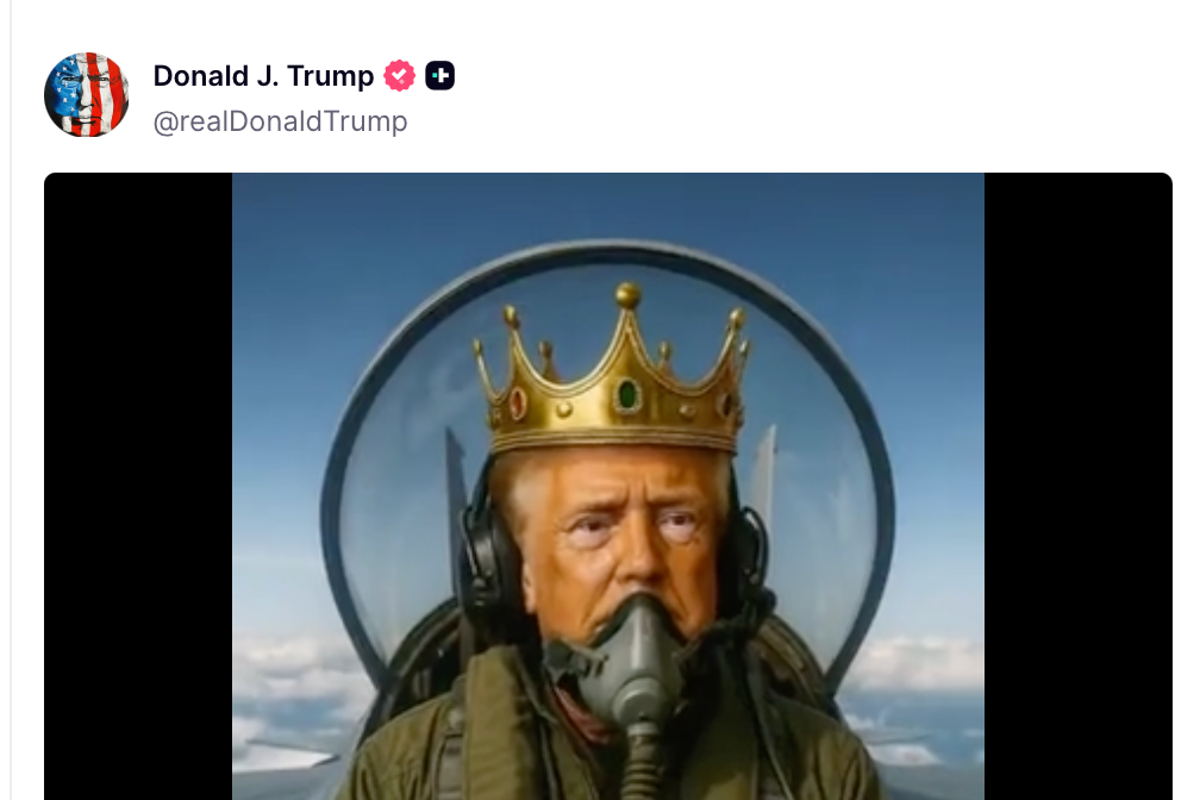In a move that has ignited widespread controversy, former President Donald Trump recently shared an AI-generated video on his Truth Social account. The video depicts Trump, self-styled as ‘KING TRUMP,’ piloting a fighter jet and dropping brown liquid onto protesters. This action follows weeks of Republican criticism concerning violent political rhetoric, raising questions about the appropriateness and potential consequences of such imagery.
The video surfaces amidst ongoing ‘No Kings’ demonstrations across the nation, organized in response to concerns over authoritarianism. As political tensions escalate, Trump’s post amplifies the existing divisions, prompting condemnation from various political factions and raising concerns about inciting violence.
This article delves into the details of Trump’s controversial post, exploring the reactions from political figures, the context of the ‘No Kings’ protests, and the broader implications of using AI-generated content in political discourse. It examines the potential impact on public sentiment and the ongoing debate over responsible communication in the digital age.
Background: The ‘No Kings’ Protests
The video emerged in the context of widespread ‘No Kings’ demonstrations held across the United States. Organizers estimate that over 100,000 individuals participated in protests spanning all 50 states. These demonstrations, fueled by concerns over governmental overreach, targeted what participants perceive as authoritarian tendencies.
In the lead-up to these protests, Republican figures responded with varying degrees of hyperbole, criticism, and mockery. House Speaker Mike Johnson labeled the rallies as “Hate America” events, while Transportation Secretary Sean Duffy accused organizers of colluding with Antifa, a movement designated by the administration as a domestic terror group.
Ezra Levin, co-founder of Indivisible, noted, “They’re clearly scared of peaceful opposition.” The White House’s attempts to link the protests to violence have been met with skepticism from organizers, who insist on maintaining a commitment to non-violent demonstration.
Republican Allies’ Reactions
In alignment with the former president’s combative stance, several Republican allies engaged in similar acts of mockery and aggressive messaging. Vice President JD Vance shared an AI-generated video depicting Trump being crowned while Democrats, including Nancy Pelosi, kneel before him.
Trump-linked accounts disseminated images of the former president wearing a crown, including a mock Time magazine cover and an AI video showcasing him draped in red velvet, waving from the White House. These actions were intended to undermine the legitimacy of the protests and reinforce Trump’s image among his supporters.
The Independent has reached out to the White House for comment, but as of this writing, no response has been received. The coordinated messaging from Republican figures suggests a deliberate strategy to discredit the ‘No Kings’ movement and rally their base.
Escalating Rhetoric and Violent Imagery
Critics highlight that the former president’s use of violent imagery is not an isolated incident. In September, amidst escalating tensions with Chicago, Trump posted an image of himself in a cowboy hat, U.S. Army fatigues, and aviator sunglasses, with military helicopters flying over a burning Chicago skyline. The image carried the slogan “Chipocalypse Now,” a reference to the film Apocalypse Now.
Trump’s accompanying message stated, “‘I love the smell of deportations in the morning…’ Chicago is about to find out why it’s called the Department of WAR.” This pattern of aggressive communication raises concerns about the potential for inciting real-world violence and further polarizing the political landscape.
These actions coincide with growing anxieties about violent rhetoric and its impact, particularly following the death of conservative activist Charlie Kirk. The argument posits that inflammatory language is fueling division and inciting violence in society.
Broader Implications and Concerns
The events described reflect broader trends in contemporary American politics. The increasing reliance on AI-generated content to shape public opinion raises ethical questions about the manipulation of information. The normalization of violent imagery in political discourse contributes to a climate of fear and hostility.
The deployment of federal immigration agents in cities over the objections of local officials, coupled with the push to deploy National Guard troops, highlights concerns about governmental overreach and the militarization of law enforcement. These actions exacerbate existing tensions and raise questions about the protection of civil liberties.
Moving forward, it’s imperative for political leaders to adopt responsible communication strategies that promote unity, respect, and peaceful dialogue. The use of AI and social media requires careful consideration of potential consequences and a commitment to ethical practices.
Conclusion: Navigating a Polarized Landscape
Donald Trump’s recent Truth Social post, featuring an AI-generated video of himself bombing protesters, underscores the escalating tensions in American politics. The post highlights a broader pattern of violent rhetoric and the use of digital tools to manipulate public opinion. The reactions from political figures and the context of the ‘No Kings’ protests reveal deep divisions within the nation.
As AI technology becomes increasingly integrated into political discourse, it is crucial to promote ethical guidelines and responsible communication strategies. The normalization of violent imagery raises concerns about the potential for inciting real-world actions and undermining the principles of peaceful opposition. The need for constructive dialogue and mutual respect becomes more urgent than ever.
The events surrounding Trump’s Truth Social post serve as a reminder of the challenges facing American society. Addressing these challenges requires a collective commitment to unity, understanding, and a shared vision for a more inclusive and just future. The path forward demands a careful consideration of the power of rhetoric and the potential impact of digital communication on the fabric of democracy.

Leave a Reply